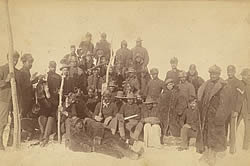Buffalo Soldiers

Overview
This resource is a Social Studies student activity that utilizes Utah's Online School Library resources - specifically, Gale's Kids Infobits Grade K-6, Gale's Research in Context Grades 6-8, and Gale's Reference Collection Grades 9-12 to help students learn about the Buffalo Soldiers.
About Utah’s Online School Library
Utah's Online School Library provides Utah educators and students free access to high-quality reference collections.
This activity was designed to help educators utilize this amazing resource in their classrooms.
Note: Utah educators and students visiting Utah's Online School Library from a school computer should be automatically authenticated. When at home, students must use the home access login that their teacher or school media specialist can provide. Utah educators can use either their my.uen login or the home access login.
Activity
Essential Question: How did the Buffalo Soldiers contribute to the growth of the U.S. western frontier during the 1800s? How did they serve their country in the 20th century?
Buffalo Soldiers were African-American soldiers who were part of all-black regiments of the U.S. Army. These special regiments had been created by the U.S. Congress in 1866. There were eventually two cavalry regiments and two foot soldier regiments. Each regiment consisted of about 1,000 men. The regiments were part of the regular U.S. army, but they lived and served separately from white regiments.
Much of the early service of the Buffalo Soldiers involved keeping peace in the West—in the frontier of the westward expanding United States. It is said that the name Buffalo Soldiers was given to these regiments by Cheyenne Native Americans who were in battle with them; the Cheyenne thought that the soldiers fought fiercely and strongly like buffalo. Other documentation indicates that the name came from Native Americans who, in addition to citing bravery in battle, also noted the thick, curly hair of the soldiers and thought that it was similar to buffalo hair.
What role did the Buffalo Soldiers play in the "taming" of the West? How were they treated in the forts that were erected for settlers? Were they treated the same as the white soldiers? How were they involved with the expansion of telegraph wire to link the outlying areas to eastern cities? What was their relationship with Native Americans? How were the Buffalo Soldiers involved with the new Indian reservations? What was their relationship with the famous Apache Indian chief, Victorio? What was their involvement with Mexican bandits? How did they help stagecoaches? What was their involvement with the infamous massacre at Wounded Knee Creek in South Dakota? What role did they play in the Spanish American War in 1898? How were Buffalo Soldiers involved with President Theodore Roosevelt?
The majority of young Buffalo Soldiers joined the Army in the years after the Civil War. However, new recruits continued to join even into the 20th century. All-black Buffalo Soldier units served in World War I, World War II, and the Korean War. In 1953, when all Army regiments became desegregated, the Buffalo Soldiers became part of history.
Utah's Online School Library has abundant resources about the Buffalo Soldiers. Check out Gale in Context Elementary. Gale's Research in Context Grades 6-8 has biographies of some of the soldiers, images, magazine articles, and a variety of other reference materials. Gale's Reference Collection Grades 9-12 is an excellent resource for secondary students and provides many academic journal articles, magazine articles, book excerpts, and newspaper articles.
Curriculum Connections:
Social Studies - 5th Grade
Social Studies - 8th Grade
Secondary - Social Studies - United States History I